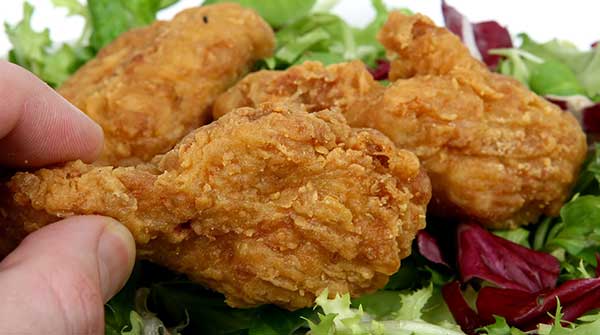Hundreds of companies are developing lab-grown food in the U.S. and over a dozen in Canada
 We knew it was just a question of time, and we know the time is now. The Food and Drug Administration (FDA) just authorized the sale of cultivated chicken in the U.S., giving safety approval for human consumption to Upside Foods, a San Francisco-based start-up. The company produces meat grown from animal cells, without killing one single animal.
We knew it was just a question of time, and we know the time is now. The Food and Drug Administration (FDA) just authorized the sale of cultivated chicken in the U.S., giving safety approval for human consumption to Upside Foods, a San Francisco-based start-up. The company produces meat grown from animal cells, without killing one single animal.
While the FDA is on board, and although the agency found Upside Foods’ chicken safe to eat, the product is not approved to be sold commercially – yet. The U.S. Department of Agriculture and its Food Safety and Inspection Service also need to approve the product. But the most significant hurdle was indeed the FDA, which means the day we see lab-grown chicken on the market is within reach.
The production process is not that complex, though the science behind it certainly is. It starts by taking a sample of primary cells from a live chicken or fertilized egg. Once done, cells are fed in a lab (just as you would feed animals in a barn) with amino acids, fatty acids, sugars, trace elements, salts, and vitamins.
 |
| Related Stories |
| Edmonton startup in race to develop lab-grown meat
|
| Lab-grown coffee – agriculture’s rising revolution
|
| Lab-grown meat is worthless unless consumers see a benefit |
The main distinction between feeding a live animal versus feeding cells is the size of the feed components. That’s it. While chicken is fed corn, cells are fed microscopic carbohydrates and proteins. Products are then put in a cultivator to reproduce more cells.
After three weeks, voilà. The product is ready to be packed, shipped, and sold. No animals were slaughtered, and the product can be designed to suit different tastes and nutritional needs. Wings, legs, or breasts can be cultivated depending on market demand.
And make no mistake, this is not fake meat. Those who condemn cultivated meat as phony simply don’t understand the science. Unlike traditional methods, cells are reproduced in a clean, sanitary lab environment and come with significant advantages.
The cost to produce a kilo of chicken in a lab remains unclear. But the economics of cultured meat production are more predictable, the production cycle is shorter and, obviously, less prone to food safety issues. Decreasing the likelihood of foodborne illness from intestinal pathogens is a clear advantage. Animal diseases like the avian flu, which currently costs a fortune to the poultry industry and consumers, can also be avoided. Risks are much easier to contain.
Hundreds of companies are developing lab-grown food in the U.S. and over a dozen in Canada. The environment and the ethical treatment of animals are becoming top-of-mind issues for a growing number of consumers, especially among younger folks who question farming practices and the industrialization of agriculture in general. Most of these initiatives are funded by investors who barely have any experience in agriculture at all, and their way of thinking is not compromised by historical biases. They just see food differently, and meat giants are forced to investigate this edge against the future of animal proteins.
The Upside Foods story is a good example. Upside Foods just acquired Cultured Decadence, a cultivated seafood company, for $400 million. A company can only raise that amount of money if the technology has some serious scientific traction.
Upside Foods started back in 2015, which is ancient history in this field. The first series of funding came from Bill Gates, Cargill, Tyson Foods, and Richard Branson, and whole Foods joined forces in 2020. While Tyson and Cargill are among the largest meat packers in the world, many influential investors have believed in the technology for a few years now.
The science is still unclear as to whether cultivated meat is healthier, but the possibilities are endless. Healthier meat can literally be designed based on consumers’ wants and needs.
Still, if you think eating cultured meat is disgusting, chances are you’re over 45 years old. In a recent survey by our lab, 27 per cent of Canadians said they would try lab-grown food. But that percentage almost triples for millennials and younger generations simply because they see these proteins as more sustainable and humane.
It is estimated that a third of all human-induced greenhouse gas emissions come from food production, leading some to advocate for different ways to produce animal proteins. Furthermore, the UN has warned the world of the risk of maintaining highly concentrated animal feeding to prevent future pandemics. These risks are real.
Cultivated chicken being sold commercially in the United States is only a matter of time. In Canada, though, with our beloved quota system, chicken farmers will have something to say about whether cultivated chicken will ever be sold commercially.
Let the lobbying games begin. But if cultivated meat is commercialized in Canada, unlike genetically modified salmon, let’s hope it’s labelled so consumers know what they are buying.
Dr. Sylvain Charlebois is senior director of the agri-food analytics lab and a professor in food distribution and policy at Dalhousie University.
For interview requests, click here.
The opinions expressed by our columnists and contributors are theirs alone and do not inherently or expressly reflect the views of our publication.
© Troy Media
Troy Media is an editorial content provider to media outlets and its own hosted community news outlets across Canada.


